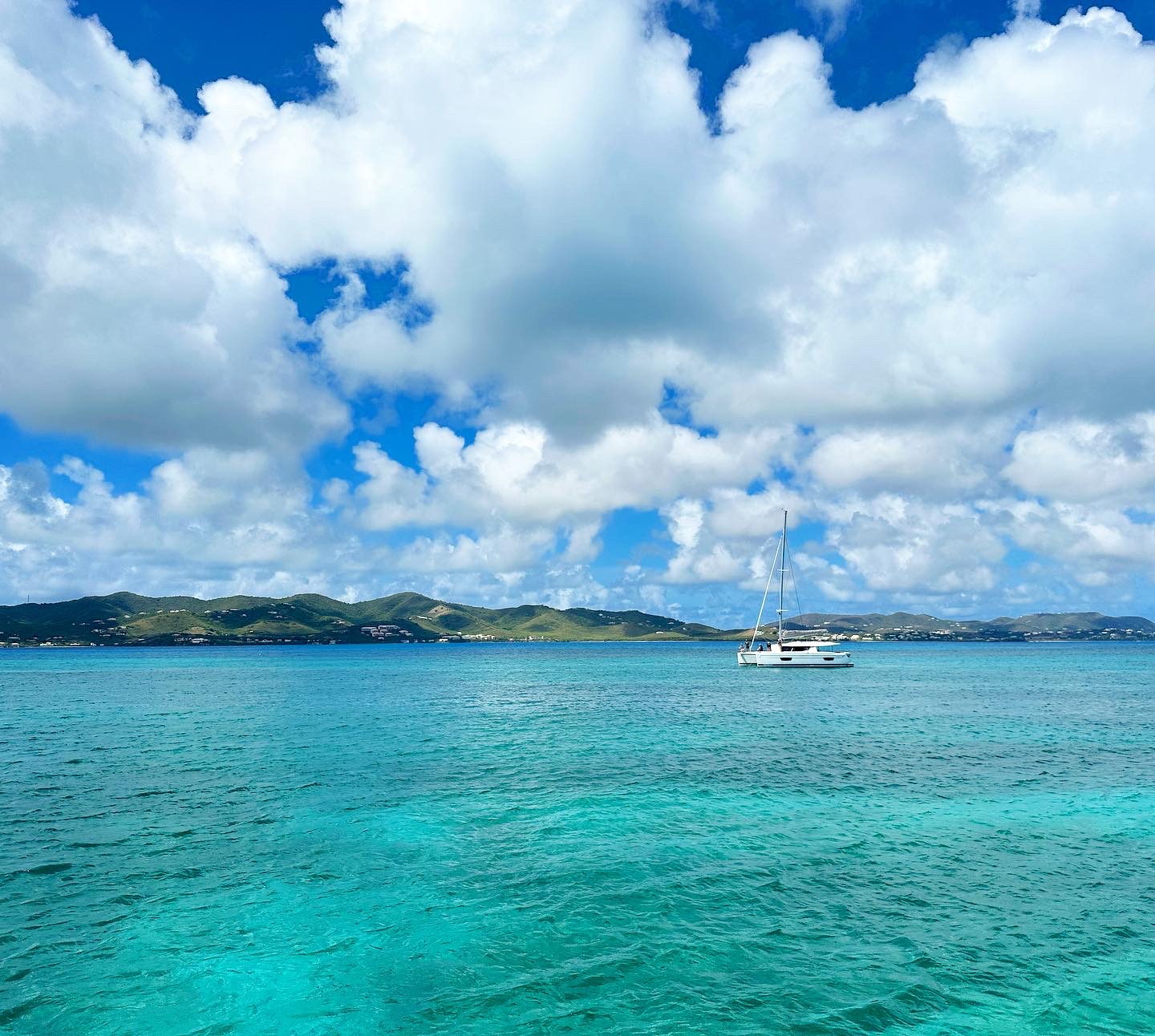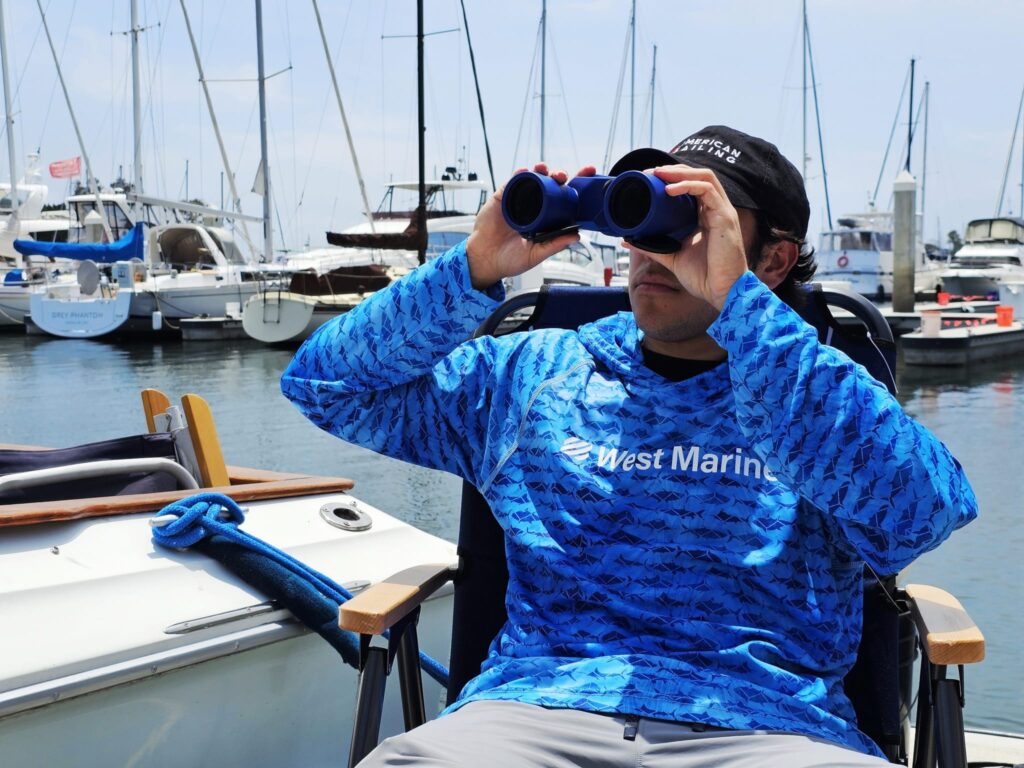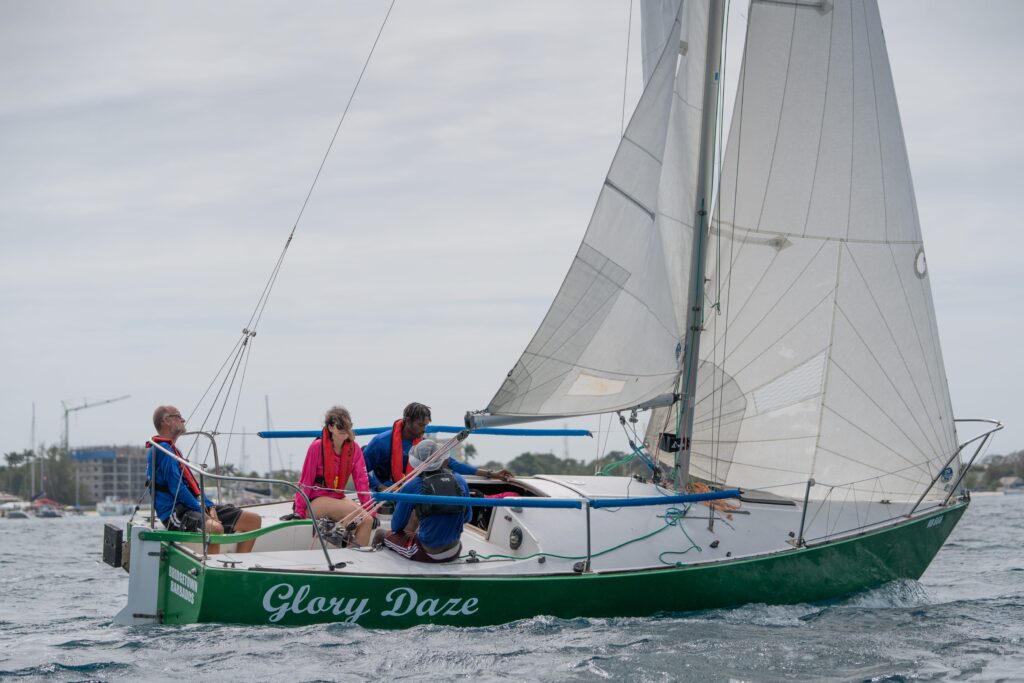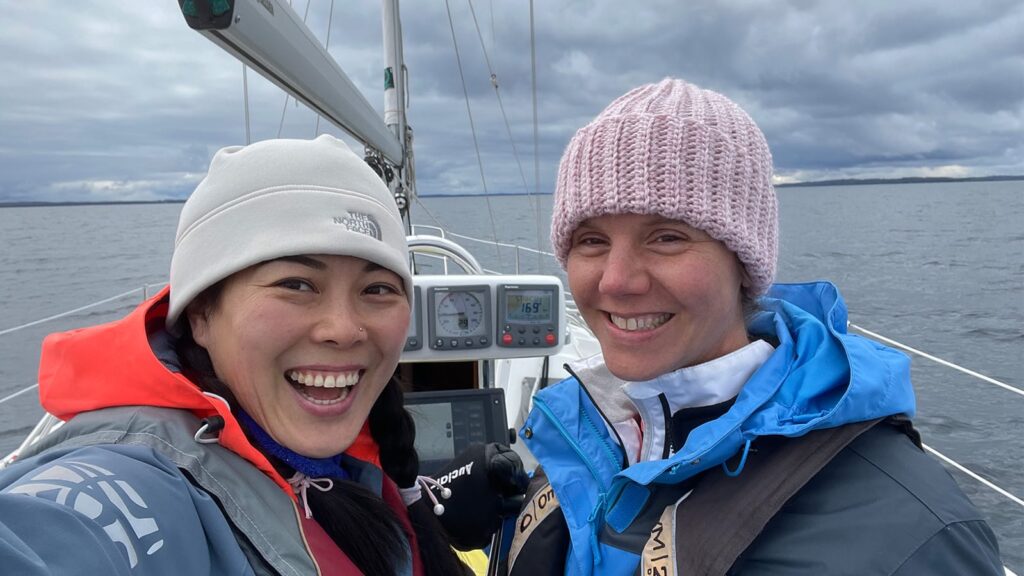By Christy McFerren, American Sailing CMO
Estimated reading time: 6 minutes
There are vacations you take for rest, and then there are vacations that I would classify as Type 2 fun. Just the invitation charges your soul with a hint of “can I really do it?”. To say yes to the journey is to say “challenge accepted.” Type 2 fun is the kind of fun that is fun when it’s over, and you’re glad you came and earned the stories. It will change you.
An invitation from Outbound Sailing School to spend a week aboard a 44-foot Fountaine Pajot catamaran in the Virgin Islands to earn our ASA-106 and ASA-114 certifications turned out to be both types of fun for me and my husband. It was an unforgettable blend of turquoise horizons, beautiful sunsets, snorkeling on colorful reefs, and taking in the salt spray while sailing at 11 knots, and also lessons that stretched far beyond what any sailing textbook can teach.
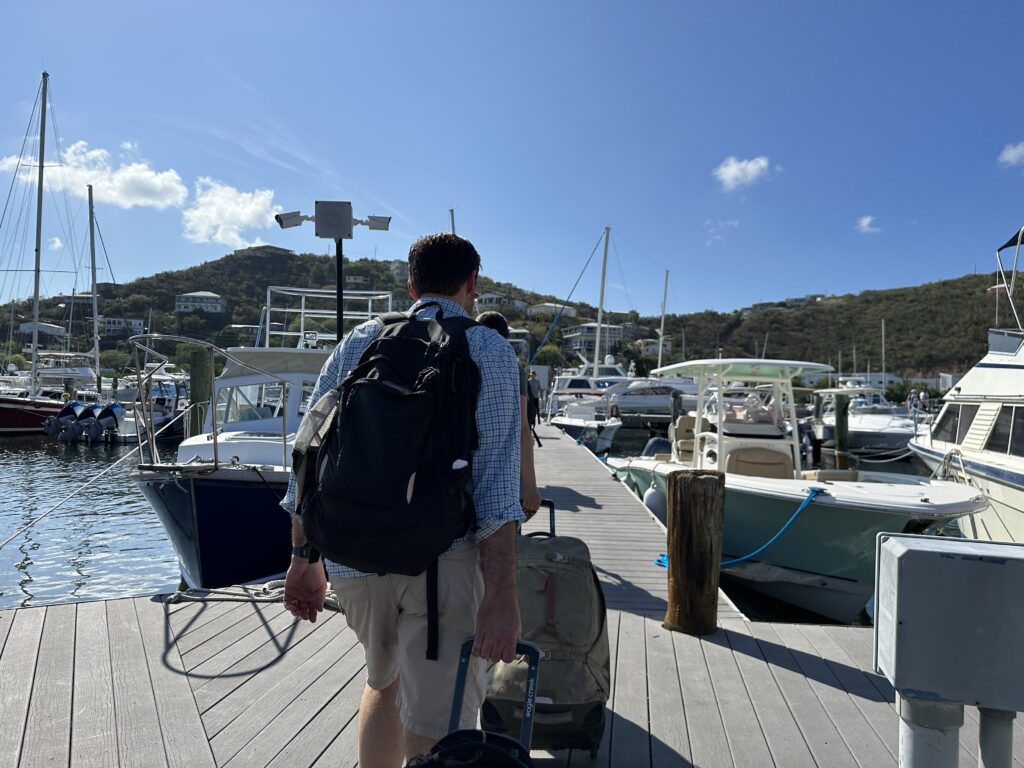
Our adventure began in St. Thomas, where we joined two other couples and our captain, who was also our instructor, storyteller, playlist DJ, and island guide. The plan was simple: starting in St. Thomas, we would sail to St. John, then onward to St. Croix, explore the Spanish Virgin Islands, and eventually return full circle to St. Thomas. But as any sailor knows, the sea writes her own version of the itinerary.
What unfolded was more than a sailing course. It was a moving classroom, an experiment in teamwork, and a journey that demanded both skill and self-awareness. We came for certifications and left with something larger: a deeper understanding of what it means to live at sea, even for a short while.
Here are the five most enduring lessons I took home from that voyage.
#5. Meals Matter More Than You Think
Before casting off, provisioning felt like a checklist item: buy the food, load the boat, stow it away. What I didn’t anticipate was how central meals would become to the rhythm of our days.
Cooking at sea requires creativity, patience, and balance. The galley is small, the fridge is limited, and no one wants to be stuck preparing elaborate dinners after a day of trimming sails and standing watch. But by planning meals ahead of time and rotating responsibilities, our crew turned dinners into highlights.
Every night, the day ended with laughter around the table — sometimes swapping stories of mishaps on the water, sometimes debating navigation strategies, sometimes quietly soaking in the glow of a Caribbean sunset. The rotation kept it fair, but also created a friendly competition. Who made the best pasta? Who managed to pull off fresh fish tacos in the rolling galley? By midweek, we were awarding “Top Chef” bragging rights, and I’m pretty sure my husband won them with his homemade tortillas served at breakfast one morning!
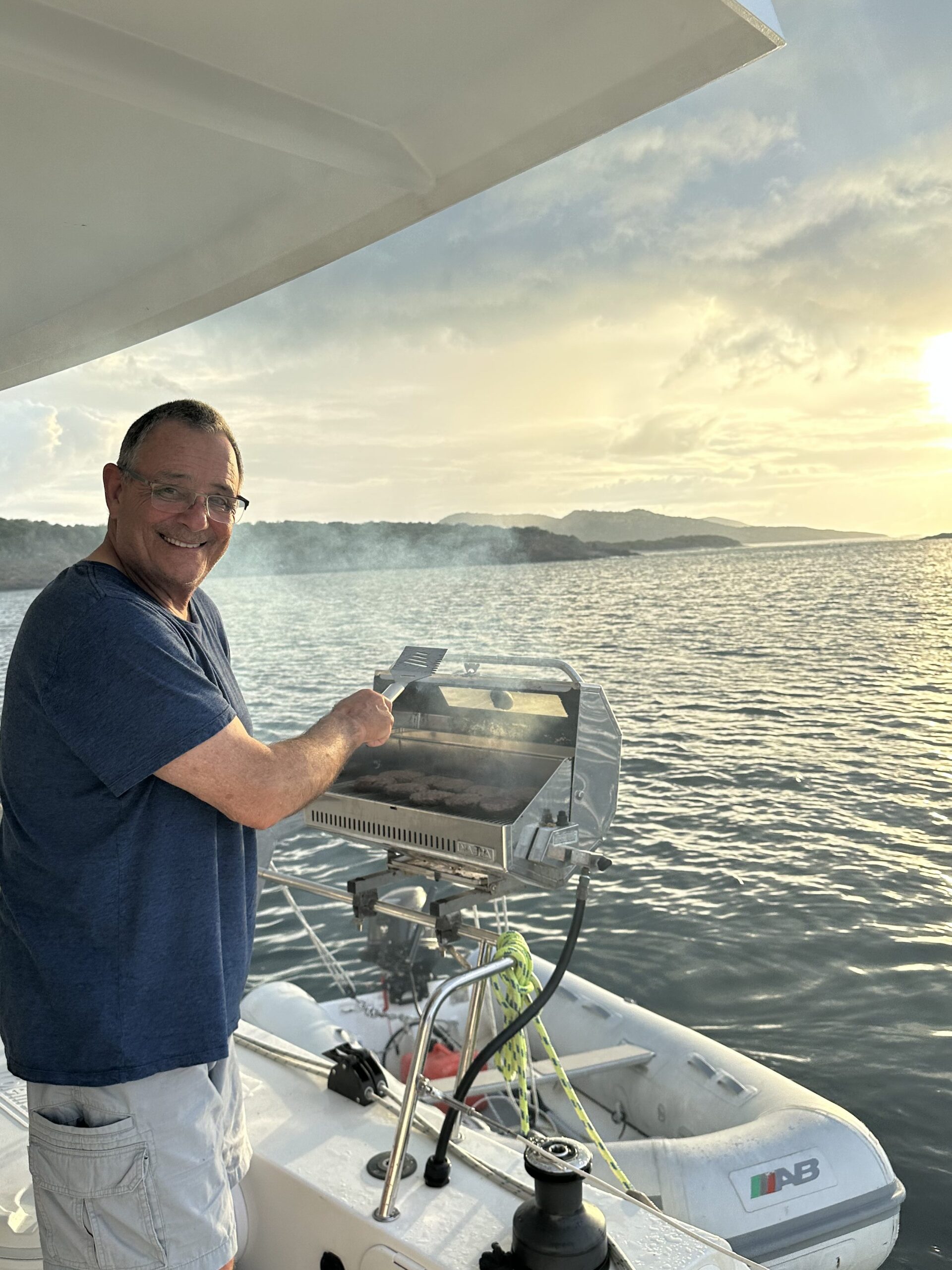
It wasn’t just about food. Those shared meals bonded us, provided comfort after hard sails, and reminded us that good provisioning is as much about morale as it is about sustenance.
#4. Clear Roles Can Prevent Events from Becoming Emergencies
Sailing isn’t without its surprises, and one afternoon we got ours. While underway, our dinghy began slipping from the davits. It was a sudden, stomach-dropping realization — the kind of moment where hesitation could mean losing the tender to the sea, meaning no more shore access for the rest of the itinerary. (Not to mention facing the fines awaiting us from the charter company when we returned to shore.)
What saved us wasn’t luck, but preparation. Each of us already knew our responsibilities. Two crewmates jumped to secure the dinghy lines while I, at the helm, hove to and monitored AIS. We were in a cruise ship traffic lane, and timing was critical. Every few minutes I relayed updates on how quickly the large vessel was closing in, estimating the time for the others to finish the repair.
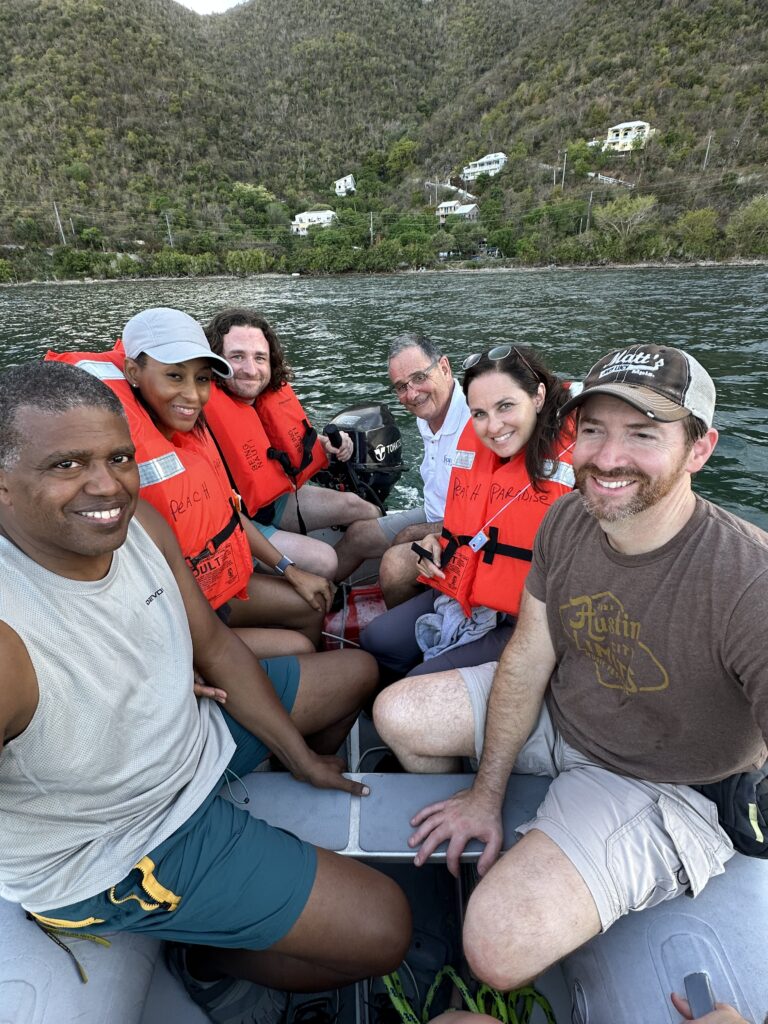
The entire episode was over in ten minutes, but it crystallized one of the most important truths of sailing: a well-drilled crew is a safe crew. Simple equipment failures can turn into emergencies, and small problems must be addressed with clarity before they snowball. These moments don’t allow for confusion about whose responsibilities lie where. When everyone understands their role and communication flows clearly, a potentially serious situation becomes manageable. That day, it was a loose dinghy. Tomorrow, it could be a sudden squall, a fouled line, or worse. The principle remains the same — preparation is everything.
When it was no longer an issue, we all laughed about our dangling dinghy and it just became a part of the trip’s building narrative — plenty of other adventures were centered around that little rubber boat, but I’ll save those for another time.
#3. Seamanship Extends Beyond the Technical
Navigation, sail trim, docking maneuvers — these are the skills you expect to practice on a sailing course. What surprised me was how equally important the “soft skills” turned out to be.
Living aboard a boat compresses space and magnifies personalities. Seven adults, one catamaran, a week of long days and tight quarters — it’s the perfect recipe for friction if you’re not mindful. I quickly realized that emotional self-government mattered just as much as knot-tying, and I could only control the controllables — which are the emotions and responses within me and no one else.
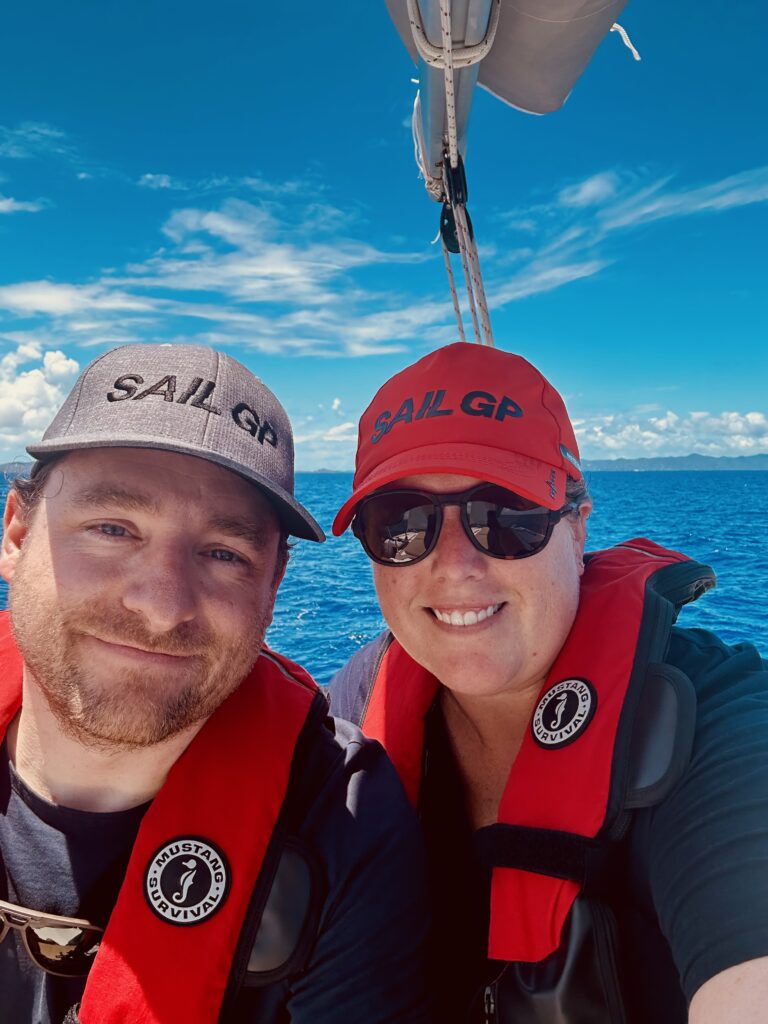
Tensions surfaced occasionally: a difference of opinion over course strategy, frustration when anchoring proved trickier than expected, or simply the fatigue of back-to-back days in the sun. The way we managed those moments shaped the tone of the entire trip.
The unwritten rules of good seamanship came into play — patience, humor, and knowing when to step back. Little acts of generosity mattered: making coffee for the morning watch, lending a hand without being asked, or choosing not to press a point in an argument. Conflict management wasn’t a front-and-center component in the ASA syllabus, but it was essential to keeping every day enjoyable.
At sea, you discover that resilience isn’t only about handling wind shifts or sudden squalls. It’s about maintaining balance within yourself and your crew.
And, it turns out that one of the couples on the boat are still our friends. We recently just purchased their Catalina 27 at a “friends and family” price point and maintain regular contact with them!
#2. Old-School Navigation Builds Confidence
In an age of satellite GPS and autopilot, it’s easy to forget that sailors managed for centuries with nothing more than a compass, charts, and patience. Our captain made sure we didn’t.
We split into two groups each leg of the trip: one using modern Garmin GPS and autopilot, the other navigating with paper charts, parallel rules, dividers, and the Coast Pilot. At first, it was intimidating to find you had drawn the “traditional” group straw — why wrestle with latitude and longitude, magnetic variation, and giant unwieldy paper charts when a screen can pinpoint your position instantly? But soon, we discovered the quiet satisfaction of plotting a course by hand and confirming it against landmarks.
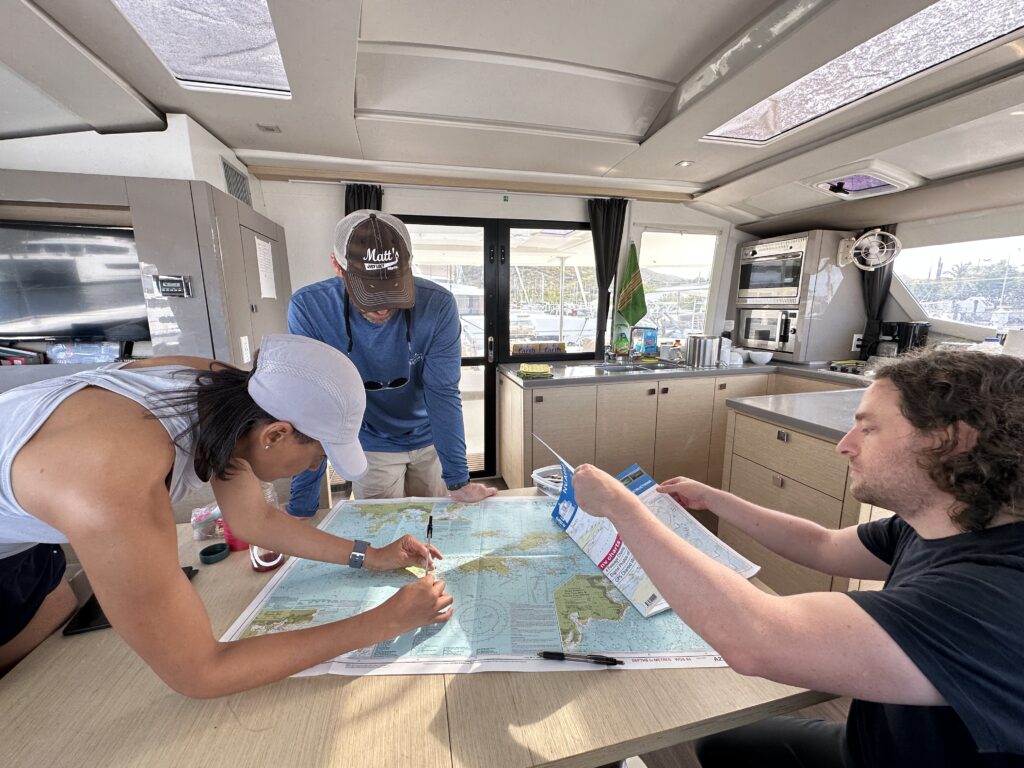
There was a rhythm to it: measure, mark, plot, double-check. Each successful fix built confidence. It wasn’t just practice for the seemingly unlikely event that electronics fail; it was a way of engaging with the sea more directly, stripping away the digital filter.
By the end of the trip, many of us found the old-school approach more rewarding. It slowed us down, forced us to pay attention, and connected us to generations of sailors who found their way across oceans with nothing more than stars and charts. When I returned home and got a tattoo of a compass, I felt like I earned my ink!
Oh, and the auto-pilot did end up failing during the trip.
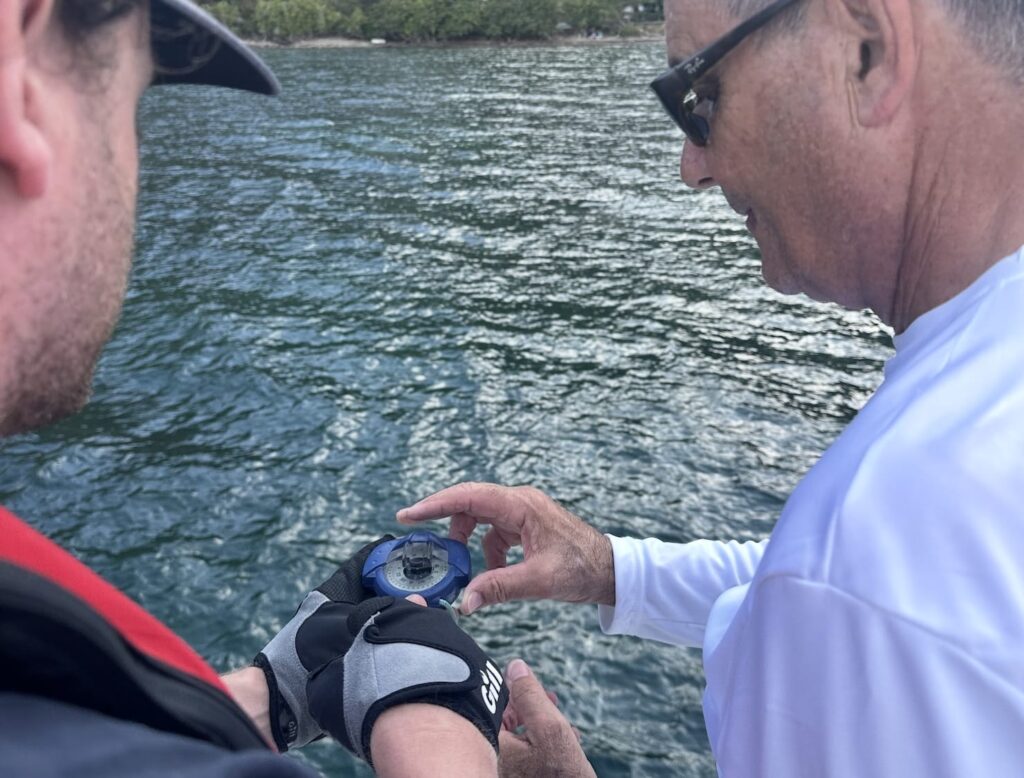
#1. The Sea Always Has More to Teach
The greatest lesson of all was also the simplest: humility.
Once you’ve been at sea for a week, you realize how vast the knowledge of sailing truly is — and how small your own piece of it is. Whether chasing ASA certifications, practicing new skills, or simply listening to our captain’s stories of transatlantic passages — including how he handled a death aboard — it became clear that sailing is a lifelong education and you can never anticipate everything that will happen.
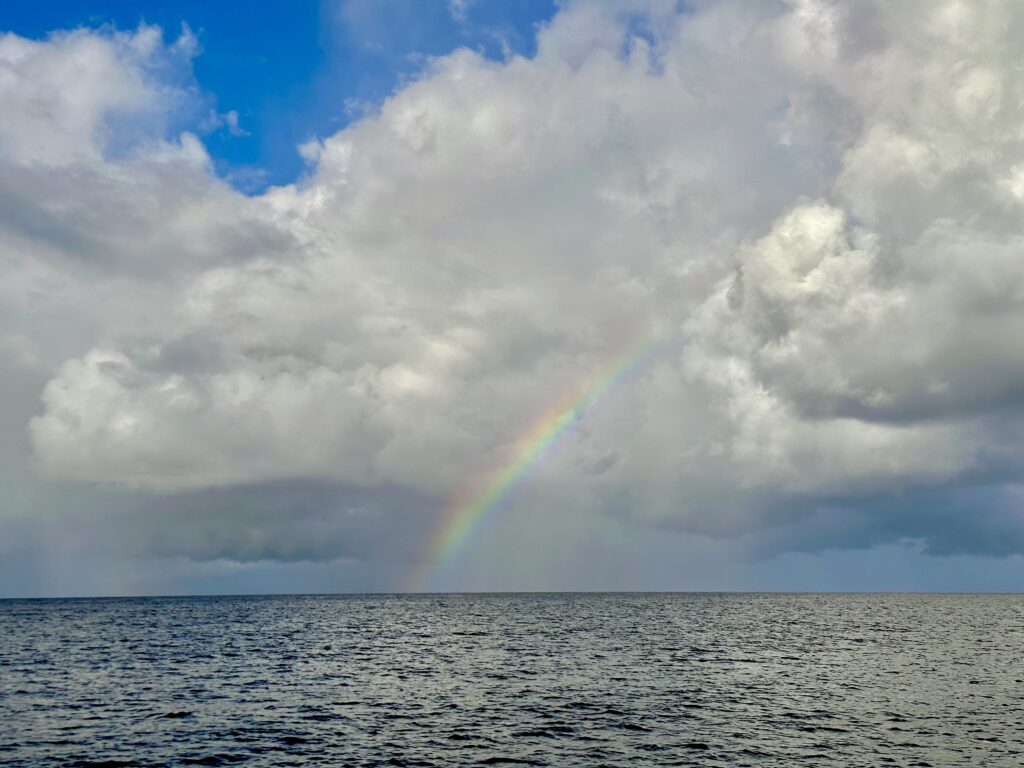
The ocean has a way of reminding you who’s in charge. A sudden squall near Vieques, a current that pushed us off our intended line into St John, seasickness after a day snorkeling in the sun off Buck Island near St. Croix, even the quiet power of an open horizon when no land is in sight — each moment whispered the same truth: you are a guest here.
Those humbling moments opened me to something deeper. Once you’ve lived through some of the lessons the ocean has to teach you, a part of you stays there. Even back on shore, I find myself daydreaming about the way the stars created a canopy over the sky as I lay on the trampoline to sleep at night, the glint of tarpon catching the light under the boat as we feasted on dinner with the sounds of a sailor’s playlist dancing across the waters, the rise and fall of the boat as she surfed 10 foot swells, and the way the sea seems to settle into your soul, making herself at home there.
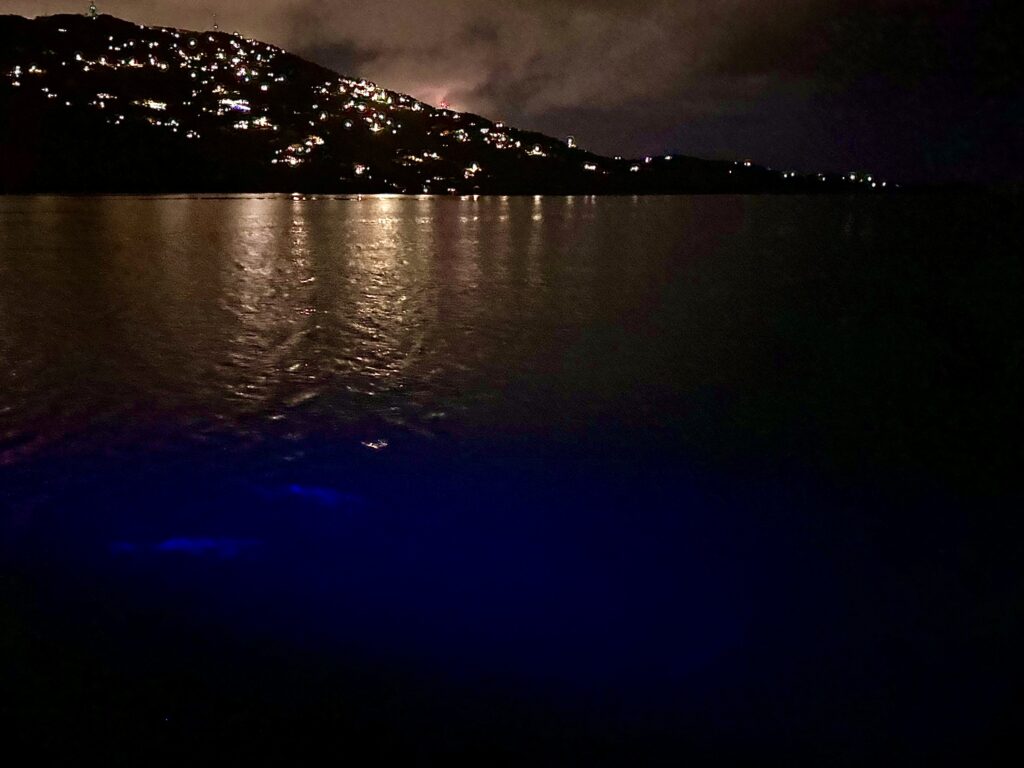
Learn-to-Sail: A Vacation That Becomes Part of You
This sailing vacation began as a practical pursuit — a chance to earn certifications and build competence. It ended as something much larger. It was about teamwork in the face of challenges, laughter around a galley table, the discipline of navigation, and the quiet lessons of humility.
Travel often promises transformation, but sailing delivers it in ways both tangible and subtle. You learn new skills, yes, but you also learn about yourself and the people you sail with. You learn to trust the sea, to respect her rhythms, and to find joy in the unexpected.
For me, the week was proof that sailing is not just a pastime but a practice, a way of moving through the world that balances skill with humility, freedom with responsibility. And while the voyage ended in St. Thomas, its imprint remains — the ocean set her anchor within my soul.
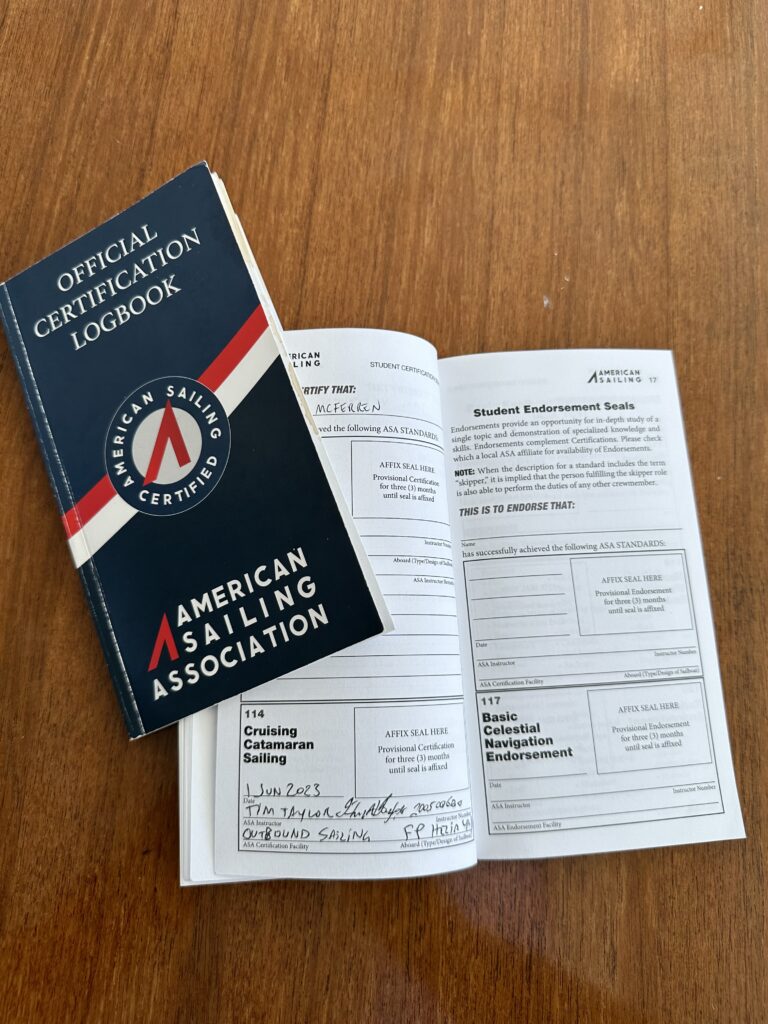
Your Turn?
Ready to cast off the lines and accept the challenge?
Take a look at some of our learn-to-sail vacations and come home with your own stories to tell.


